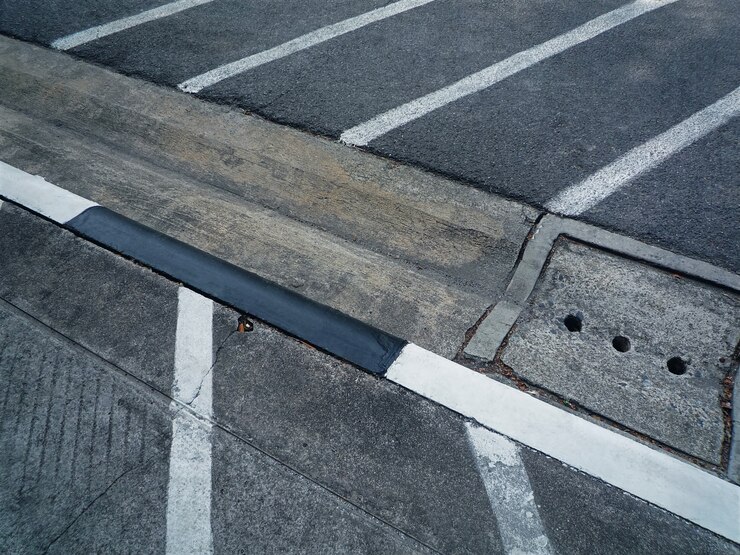BUSINESS
Your Ultimate Guide to Steel Road Plates

Picture yourself driving down a busy city street, taking in all the sights and sounds of city life. Under your car’s wheels is a network of steel road plates. Your journey into the world of steel road plates starts with this complete guide.
What is a Steel Road Plate?
A steel road plate is like a big, strong metal sheet that’s placed on the ground to cover up holes or trenches in the road or sidewalk. It’s made of steel, which is tough and durable, so it can support heavy vehicles driving over it without breaking.
Types of Steel Road Plates
Smooth Steel Road Plates
Smooth steel road plates are flat, heavy-duty plates made from steel. They are commonly used to cover trenches, excavations, or roadwork areas temporarily to allow traffic to pass over safely.
Smooth steel road plates provide a smooth surface for vehicles to drive on and are often used in urban areas where traffic flow needs to be maintained. These plates are typically made from high-quality steel and come in various sizes and thicknesses to accommodate different roadwork needs.
Trench Plates
Trench plates, also known as steel trench covers or road plates, are heavy-duty steel plates used to cover open trenches or excavations temporarily. They provide a stable surface for vehicles and pedestrians to pass over safely while construction or utility work is ongoing below.
Trench plates are designed to withstand the weight of heavy vehicles and equipment without bending or warping. They often have non-skid surfaces to enhance traction and prevent accidents.
Anti-Skid Steel Road Plates
Anti-skid steel road plates are similar to smooth steel road plates but have surface treatments or textures to improve traction and prevent slipping, especially in wet or icy conditions.
These plates are commonly used in areas where safety is a concern, such as construction sites, temporary road closures, or areas with heavy foot traffic. The anti-skid surface helps vehicles and pedestrians maintain control and stability when driving or walking over the plates
Benefits of Steel Road Plates
Durability and Strength for Heavy-Duty Applications
Steel road plates are incredibly durable and strong, making them ideal for heavy-duty applications. They can withstand the weight of heavy vehicles, machinery, and equipment without bending or warping. This durability ensures that the plates can provide a stable surface for traffic and construction activities without failing or needing frequent replacement.
Resistance to Wear, Corrosion, and Weathering
Because steel road plates do not rust or wear down easily, they can be used outside for a long time. They can withstand exposure to harsh environmental conditions, such as rain, snow, and UV rays, without deteriorating. This resistance ensures that the plates maintain their structural integrity and functionality over time, reducing the need for maintenance and replacement.
Ease of Installation and Removal
Steel road plates are relatively easy to install and remove, providing flexibility and convenience for temporary road closures and construction projects. They can be quickly placed over trenches, excavations, or roadwork areas to provide a safe passage for vehicles and pedestrians.
Similarly, they can be easily lifted and relocated when no longer needed, allowing for efficient traffic management and minimizing disruption to road users.
Applications of Steel Road Plates
Temporary Road and Sidewalk Crossings
Over excavations or construction sites, steel road plates are often used to make temporary crossings for roads and sidewalks.
These plates provide a stable surface for traffic and foot traffic, minimizing disruption to road users and ensuring smooth traffic flow during construction or repair work. They are especially useful in urban areas where maintaining access to roads and sidewalks is critical.
Bridge Decking and Repair
Steel road plates are often used for bridge decking and repair projects. They can be installed temporarily to provide a stable surface for vehicles and construction equipment during bridge maintenance or rehabilitation work.
These plates distribute weight evenly, reducing stress on the bridge structure and ensuring worker safety. Additionally, steel road plates can be used as permanent decking solutions for bridges, providing a durable and long-lasting surface for vehicular traffic.
Trench and Excavation Covers
One of the primary applications of steel road plates is to cover trenches and excavations temporarily. These plates create a safe passage for vehicles and pedestrians over open trenches, ensuring that traffic flow is maintained and construction activities can proceed safely.
Steel road plates are available in various sizes and thicknesses to accommodate different trench dimensions and load requirements, making them suitable for a wide range of excavation projects.
Event and Construction Site Access Roads
Steel road plates are frequently used to create temporary access roads for events and construction sites. These plates provide a stable surface for vehicles and equipment to travel on, even in challenging terrain or adverse weather conditions.
They can be quickly installed and removed as needed, allowing for efficient traffic management and minimizing disruption to surrounding areas.
Steel road plates are particularly useful for creating access roads in remote or temporary locations where traditional road construction methods may not be feasible.
Apply This Knowledge to Make Informed Decisions
Whether you’re a contractor, engineer, or project manager, knowing about steel road plates can help you ensure the safety and efficiency of your worksite. For reliable steel road plate solutions and expert guidance, hire steel road plates from reputable providers.
With this knowledge and the right resources at your disposal, you can confidently navigate your projects and keep your roads and worksites safe for everyone.
BUSINESS
The Smart Canadian’s Guide to Lowering Insurance Costs

Insurance is a necessity for peace of mind, but it can also make a significant dent in your budget. Whether it’s auto, home, or life insurance, your premiums can add up quickly. But here’s the bright side: there are effective ways to minimize your insurance costs without sacrificing coverage. Find expert Canadian insurance solutions with Sharp Insurance to get started on smarter savings today.
This guide is designed to help Canadians take control of their insurance expenses. By understanding how insurance pricing works and adopting a few smart strategies, you can save hundreds (or more) annually.
Shop Around and Compare Quotes
One of the simplest yet most overlooked strategies for lowering your insurance costs is shopping around. Not all insurance providers are created equal, and their pricing structures can vary significantly based on your profile, location, and coverage needs.
Use Online Comparison Tools
Websites like Ratehub or LowestRates.ca make it easier than ever to compare insurance premiums from multiple providers. These tools allow you to input your details once and receive a variety of personalized quotes. This quick process can reveal savings opportunities you may never have guessed existed.
Get Quotes from Multiple Providers
Don’t just stop at online tools. Contact insurance providers directly and ask for quotes. Some insurers may offer loyalty discounts or exclusive deals for prospective customers who inquire directly. Make sure to compare the coverage, not just the price, to ensure you’re getting the best value.
Pro Tip
Check reviews and rating platforms like the Better Business Bureau to ensure the provider not only offers competitive rates but also great service.
Increase Your Deductible
A deductible is the amount you agree to pay out-of-pocket before your insurance kicks in to cover the rest. Increasing your deductible can reduce your premium, sometimes significantly.
How Deductibles Work
For example, if you opt for a $1,000 deductible instead of $500, your monthly or annual premium will often decrease. Why? Because you’re agreeing to take on a higher portion of the risk.
Weighing the Pros and Cons
While opting for a higher deductible lowers your premium, it’s crucial to ensure that you have enough emergency savings in case you need to pay that deductible.
Consider this:
- Pros: Lower monthly premiums, potential long-term savings.
- Cons: Higher upfront costs in case of an incident.
Evaluate your financial situation and risk tolerance before increasing your deductible.
Bundle Your Insurance Policies
Bundling your insurance policies—such as auto, home, and life insurance—with the same provider is another excellent way to save. Many insurers offer discounts when you consolidate multiple policies with them.
Benefits of Bundling
- Combined discounts: Bundling can save you up to 25% on your premiums.
- Simplified management: Dealing with one provider is more convenient than juggling multiple policies from different companies.
- Extra perks: Some insurers offer enhanced customer service or loyalty rewards for bundled policies.
How to Find the Best Bundling Deals
Start by asking your current providers about bundling options. Then compare their offers with competitors to ensure you’re receiving the maximum discount. Remember to confirm that you’re not losing any important coverages in the process of bundling.
Improve Your Credit Score
Did you know that your credit score can impact your insurance premiums in Canada? Insurers often use your credit score as an indicator of how “risky” you might be to insure. The better your score, the lower your premiums may be.
The Connection Between Credit Scores and Insurance Rates
Insurance companies view individuals with higher credit scores as more responsible and less likely to file frequent claims. While not all provinces allow the use of credit score assessments (Quebec and Newfoundland and Labrador, for example, restrict this practice), in most provinces, keeping a good credit score is advantageous.
Tips for Improving Your Credit Score
- Pay bills on time: Late payments negatively affect your score.
- Keep your credit utilization low: Aim to use less than 30% of your credit limit.
- Monitor your credit report: Check for errors or inaccuracies that could be dragging down your score.
Improving your credit score takes time, but the financial benefits go beyond insurance savings, impacting other areas of your financial life as well.
Take Advantage of Discounts
Many insurance providers offer a variety of discounts that customers aren’t often aware of. By knowing what to look for, you may unlock significant savings.
Available Discounts
- Student discounts: Young drivers in school can access reduced auto insurance rates.
- Senior discounts: Retirees and seniors typically qualify for discounts on auto and home insurance.
- Professional discounts: Belong to a union or professional organization? You might be eligible for specific group discounts.
How to Inquire About and Apply for Discounts
Be proactive! Call your insurance provider and ask for a full breakdown of discounts you qualify for. Additionally, ensure you’ve provided up-to-date details about your current circumstances, as this can often reveal overlooked savings opportunities.
Pro Tip
Participate in telematics programs if your auto insurer offers them. These programs track your driving habits and may reward you with lower rates for safe driving.
Taking Control of Your Insurance Costs
Finding ways to reduce your insurance expenses doesn’t have to be complicated. By shopping around, reevaluating your deductible, bundling policies, improving your credit score, and taking advantage of discounts, you can enjoy significant savings while maintaining excellent coverage.
Remember that being proactive and informed is key to success. Set a reminder each year to review your insurance policies and explore opportunities for additional savings.
At the end of the day, every dollar saved on insurance is a dollar you can invest elsewhere in your future. Take control of your coverage today and ensure your hard-earned money is working as efficiently as possible.
BUSINESS
When To Call for AC Repair vs. Regular Maintenance

Most problems of an air conditioning system may seem minor at first, but can evolve into more severe disruptions when left unresolved. Preventive maintenance is a service to keep the system in working condition through regular checkups. Repair is needed when the unit exhibits signs of mechanical or electrical failure. Here is when to schedule for AC repair versus regular maintenance:
Temperature Variations
Restricted airflow, failing motors, or internal refrigerant imbalances often cause uneven cooling. Although maintenance clears surface-level buildup and aids airflow, persistent temperature variation in different rooms may indicate faulty internal controls or deteriorated circulation systems. The parts responsible for distributing air evenly might have become misaligned or are no longer working correctly. Such fluctuations often persist as performance regulators within the system start to fail. When this happens, a professional may need to replace a part. When such symptoms occur, professional AC repair helps to detect underlying faults, recalibrate settings, or replace worn-out components.
Persistent Airflow Issues
Even after a system has undergone routine maintenance, airflow issues may still be present. Decreased airflow may occur due to electrical irregularities affecting the blowers’ functioning, pressure imbalances, or deteriorating fan performance. Although regular service may involve cleaning and filter replacement, airflow limitations due to internal damage or system wear may go unaddressed. These conditions may worsen when the blower assembly becomes weak, resulting in the unit having less capacity to force air through the vents. Air passage can also be disrupted by disconnected or damaged internal seals, which lowers overall efficiency. A professional will diagnose and repair the issue.
Unusual Cycling Behavior
Cooling systems should cycle at a normal rate. Internal sensors or electrical control elements may be compromised when they are turned on and off too often. Alternatively, when a unit fails to cycle off, the root cause may be temperature control errors or a cooling load imbalance. Short cycling and long operation wear the system. Relays and communication boards that control these cycles may lose calibration or deteriorate over time. Professional repair is necessary to diagnose and address the underlying cause, avoiding further degradation and restoring proper cycling functionality.
Unusual Noises
The noise from the unit may increase as internal parts wear out or become misaligned. Rattling is usually an indication of loose mechanical components, and buzzing sounds may occur due to power fluctuations or faulty electrical components. Maintenance may involve general inspection or oil application, but not opening assemblies or replacing damaged parts. When such noises are repeated, subsequent use of the system may cause further internal damage. This is when you should get targeted mechanical repair to promote smooth operation and avoid cascading system failure.
Drainage Problems and Moisture Accumulation
The presence of moisture around the air conditioning unit may indicate drainage failure. A blocked condensate drain line is a common reason, as it prevents water from leaving the system. Dust, algae, and debris can accumulate over time within the line, eventually forming a clog that causes water to pool around the unit. When a drip pan cracks or shifts out of position, it cannot collect and channel condensation properly, leading to pooling.
If the evaporator coil freezes and thaws due to internal components, the drainage system can be overwhelmed by excess water. These problems go beyond routine servicing and require corrective action to restore proper moisture management. Repairs must aim to clear blocked drains, seal or replace broken parts, and restore system balances to prevent permanent damage and enhance reliability.
Hire an AC Repair Company
Although routine maintenance helps to maintain functionality and efficiency, it has its limits. Repair is required when performance is disrupted by mechanical, electrical, or control-based faults. Select an experienced provider in both routine maintenance and targeted repairs. An experienced team will not only keep the system clean and calibrated but will also identify when deeper intervention is required. Hire an AC repair company to access timely interventions and expert solutions.
BUSINESS
Innovative Strategies For Building A Personal Brand Online

Why Personal Branding Matters In The Digital Era
Personal branding has become a necessity in today’s digital world, with over 70% of employers and collaborators searching for individuals online before making hiring or partnership decisions. A thoughtful and intentional brand presence can make professionals recognized, trusted, and remembered. Trailblazers like Bradley Bakotic demonstrate how authenticity and strategy can create a resonating personal brand. A recognizable digital presence is about communicating your mission, values, and expertise to a broad audience, building relationships, inspiring others, and leaving a meaningful impact in your field. A personal brand built on substance and sincerity helps people remember your name and associate you with trust and reliability.
Core Elements Of An Effective Online Identity
An effective online identity requires clarity on your core message and a consistent profile across all relevant platforms, such as LinkedIn, Twitter, and personal websites. It includes a consistent headshot, a unified username, and a value-focused tagline. Authenticity sets strong personal brands apart, as sharing real stories, passions, or behind-the-scenes insights helps break down barriers and foster trust. Being candid about your journey, including its challenges and growth moments, can resonate with your audience. Honesty, combined with a visually uniform digital footprint, creates immediate recognition and drives loyalty over time. People are drawn to people, not just credentials or job titles.
How To Use Social Channels Intentionally
- Choose platforms with purpose: Focus your efforts on the platforms that your target audience frequents most. For instance, LinkedIn remains the go-to hub for professionals, while Instagram and TikTok excel for those in the creative or lifestyle spaces.
- Engage meaningfully: Don’t just broadcast—join the conversation. Make it a habit to reply to comments, share perspectives in group threads, and participate in online events or Q&As.
- Stay consistent yet flexible: Develop a regular posting schedule and remain adaptable. The audience needs to shift; be ready to experiment with content forms—such as stories, video snippets, and polls—to see what sparks the most engagement.
A targeted approach to social media can yield greater returns as it fosters trust, collaboration, and advocacy. Analytics can help identify which content and timing align with the community’s interests, ensuring that your efforts are always aligned with the community’s interests.
The Role Of Storytelling & Thought Leadership
Memorable brands are built on compelling stories that capture emotional connections through both success and failure. Audiences seek transparent, open, and passionate voices about progress. Personal anecdotes about career paths, pivots, and lessons learned foster empathy. The best brands position themselves as trusted experts by sharing unique opinions and insights on industry trends. Authentic stories and thoughtful commentary are viewed as leaders within their fields. Real-world impact is achieved when storytelling and thought leadership are combined, allowing expertise and humanity to shine.
Strategic Content Creation For Maximum Engagement
- Pinpoint your audience’s questions: Identify community challenges and pain points to provide actionable content that enhances professional or personal growth, as attention spans are short.
- Pack posts with actionable value: Create a variety of content formats, including how-to guides, tutorials, infographics, and video explainers, to simplify complex topics and demonstrate your expertise and willingness to empower others.
- Recycle and customize content: One great post can reach new audiences, such as a tweet thread, an email newsletter, or even a short video. Repurposing ensures your message is heard on multiple platforms while respecting the unique consumption habits of each audience segment.
Forbes highlights that compelling, story-driven content outperforms promotional posts on social channels, as it encourages participation, addresses real-world questions, and inspires responses, thereby boosting awareness and engagement.
Measuring Impact And Adapting Your Brand
An effective personal brand matures through continuous monitoring and adaptation. Utilize analytics tools to observe engagement rates, follower growth, and demographics. Look for patterns in post-reception, such as specific times or global events. Be agile and experiment with new content themes or formats based on user feedback. Pay attention to the quality of engagement, including the frequency of questions, sharing, and opportunities. For interaction, it helps refine your message and deepen digital relationships.
Emerging Trends In Personal Branding
Personal branding must adapt to rapidly changing digital trends, such as short-form video formats like Instagram Reels, TikTok videos, and YouTube Shorts, which effectively capture attention and foster deeper connections with audiences. Integrating interactive elements, such as Q&A sessions or live streams, can further enhance brand engagement and interaction. The responsible use of AI for content ideation and optimization is crucial, but transparency and accessibility are equally essential. Staying updated on algorithm changes, new content formats, and digital etiquette ensures a fresh, relevant, and impactful brand.
Common Pitfalls And How To Avoid Them
- Over-promotion: Balance is crucial. While sharing achievements is fantastic, audiences quickly disengage from constant self-promotion. Deliver real, regular value through educational, relatable, and inspiring content.
- Lack of consistency: Irregular updates erode trust and recall. Create a manageable schedule and stick to it, even if it’s just once or twice per week.
- Failure to listen: Engagement is a two-way street. Make active listening part of your strategy—respond to comments, encourage feedback, and adapt readily to changes in your community’s needs.
- Overexposure: Striking a balance between personal sharing and privacy is vital. Protect sensitive information and remember that being authentic doesn’t mean revealing every detail.
Maintaining a healthy and impactful brand presence requires awareness of common missteps, staying tuned to followers, adapting to changing digital norms, and communicating with clarity and heart.
-

 GENERAL2 years ago
GENERAL2 years agoDiscovering the Artistic Brilliance of Derpixon: A Deep Dive into their Animation and Illustration
-

 Posts2 years ago
Posts2 years agoSiegel, Cooper & Co.
-

 FASHION2 years ago
FASHION2 years agoThe Many Faces of “λιβαισ”: A Comprehensive Guide to its Symbolism in Different Cultures
-

 Lifestyle2 years ago
Lifestyle2 years agoPurenudism.com: Unveiling the Beauty of Naturist Lifestyle
-

 Lifestyle2 years ago
Lifestyle2 years agoBaddieHub: Unleashing Confidence and Style in the Ultimate Gathering Spot for the Baddie Lifestyle
-

 HEALTH1 year ago
HEALTH1 year agoTransformative Health Solutions: Unveiling the Breakthroughs of 10x Health
-

 Entertainment2 years ago
Entertainment2 years agoGeekzilla Podcast: Navigating the World of Pop Culture, Gaming, and Tech
-

 Lifestyle11 months ago
Lifestyle11 months agoSandra orlow: Unraveling the Story of an Iconic Figure
